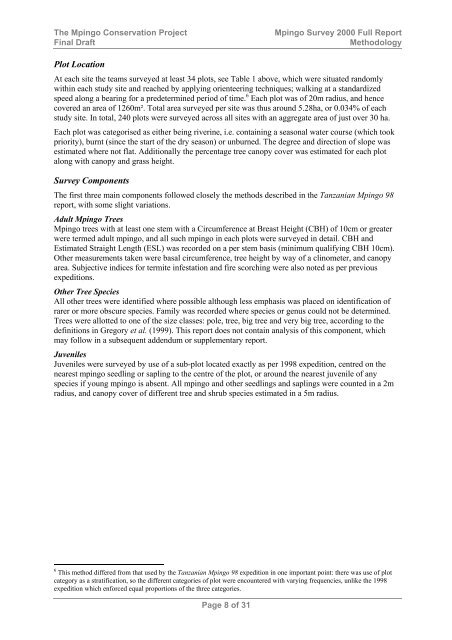the Mpingo Conservation Project - Coastal Forests of Kenya and ...
the Mpingo Conservation Project - Coastal Forests of Kenya and ...
the Mpingo Conservation Project - Coastal Forests of Kenya and ...
You also want an ePaper? Increase the reach of your titles
YUMPU automatically turns print PDFs into web optimized ePapers that Google loves.
The <strong>Mpingo</strong> <strong>Conservation</strong> <strong>Project</strong><br />
Final Draft<br />
<strong>Mpingo</strong> Survey 2000 Full Report<br />
Methodology<br />
Plot Location<br />
At each site <strong>the</strong> teams surveyed at least 34 plots, see Table 1 above, which were situated r<strong>and</strong>omly<br />
within each study site <strong>and</strong> reached by applying orienteering techniques; walking at a st<strong>and</strong>ardized<br />
speed along a bearing for a predetermined period <strong>of</strong> time. 6 Each plot was <strong>of</strong> 20m radius, <strong>and</strong> hence<br />
covered an area <strong>of</strong> 1260m². Total area surveyed per site was thus around 5.28ha, or 0.034% <strong>of</strong> each<br />
study site. In total, 240 plots were surveyed across all sites with an aggregate area <strong>of</strong> just over 30 ha.<br />
Each plot was categorised as ei<strong>the</strong>r being riverine, i.e. containing a seasonal water course (which took<br />
priority), burnt (since <strong>the</strong> start <strong>of</strong> <strong>the</strong> dry season) or unburned. The degree <strong>and</strong> direction <strong>of</strong> slope was<br />
estimated where not flat. Additionally <strong>the</strong> percentage tree canopy cover was estimated for each plot<br />
along with canopy <strong>and</strong> grass height.<br />
Survey Components<br />
The first three main components followed closely <strong>the</strong> methods described in <strong>the</strong> Tanzanian <strong>Mpingo</strong> 98<br />
report, with some slight variations.<br />
Adult <strong>Mpingo</strong> Trees<br />
<strong>Mpingo</strong> trees with at least one stem with a Circumference at Breast Height (CBH) <strong>of</strong> 10cm or greater<br />
were termed adult mpingo, <strong>and</strong> all such mpingo in each plots were surveyed in detail. CBH <strong>and</strong><br />
Estimated Straight Length (ESL) was recorded on a per stem basis (minimum qualifying CBH 10cm).<br />
O<strong>the</strong>r measurements taken were basal circumference, tree height by way <strong>of</strong> a clinometer, <strong>and</strong> canopy<br />
area. Subjective indices for termite infestation <strong>and</strong> fire scorching were also noted as per previous<br />
expeditions.<br />
O<strong>the</strong>r Tree Species<br />
All o<strong>the</strong>r trees were identified where possible although less emphasis was placed on identification <strong>of</strong><br />
rarer or more obscure species. Family was recorded where species or genus could not be determined.<br />
Trees were allotted to one <strong>of</strong> <strong>the</strong> size classes: pole, tree, big tree <strong>and</strong> very big tree, according to <strong>the</strong><br />
definitions in Gregory et al. (1999). This report does not contain analysis <strong>of</strong> this component, which<br />
may follow in a subsequent addendum or supplementary report.<br />
Juveniles<br />
Juveniles were surveyed by use <strong>of</strong> a sub-plot located exactly as per 1998 expedition, centred on <strong>the</strong><br />
nearest mpingo seedling or sapling to <strong>the</strong> centre <strong>of</strong> <strong>the</strong> plot, or around <strong>the</strong> nearest juvenile <strong>of</strong> any<br />
species if young mpingo is absent. All mpingo <strong>and</strong> o<strong>the</strong>r seedlings <strong>and</strong> saplings were counted in a 2m<br />
radius, <strong>and</strong> canopy cover <strong>of</strong> different tree <strong>and</strong> shrub species estimated in a 5m radius.<br />
6 This method differed from that used by <strong>the</strong> Tanzanian <strong>Mpingo</strong> 98 expedition in one important point: <strong>the</strong>re was use <strong>of</strong> plot<br />
category as a stratification, so <strong>the</strong> different categories <strong>of</strong> plot were encountered with varying frequencies, unlike <strong>the</strong> 1998<br />
expedition which enforced equal proportions <strong>of</strong> <strong>the</strong> three categories.<br />
Page 8 <strong>of</strong> 31
















